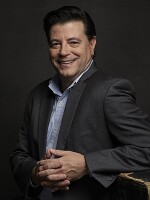With songs like “Aqualung” and “Bungle in the Jungle,” Jethro Tull was one of the most successful progressive rock bands of the 1970s. A big part of the band’s success was their stage show — wild-eyed frontman Ian Anderson dressed in medieval garb, standing on one leg playing riffs with his flute is certainly a lasting image of the band.
I spoke with Anderson in advance of his upcoming performance at Mohegan Sun on Sunday, Oct. 29. I learned that persona is still an important part of a Jethro Tull show. I spoke to Anderson via Zoom from his home in Wiltshire, England, where he also talked about the band’s longevity, his songwriting inspirations, and the band’s latest album “RökFlöte.”
Tell me about the latest tour, “Seven Decades.”
“Seven Decades” seemed like an appropriate title given that in 2020, we began seven decades of recording and making records, which began in 1968. And so every decade since then there's been some new material. The only decade I'm slightly cheating on is the 2020s, because we actually began an album in 2017. We recorded eight tracks, but unfortunately, we didn't get finished because of the volume of touring in 2018. And then 2019 came along and COVID. And so put everything back for yet another year before finally we released the album in February of 2022. That album being “The Zealot Gene.” So it's another tour. Such being the life of the itinerant musician.
Many of these songs you have been playing for years. Is it difficult keeping them fresh and vital?
It really depends on the song. Some songs undergo some degree of change of arrangement and sometimes songs will have a variety over the years, slightly different arrangements and then maybe we go back to the version that was the original recording. I would say that out of the current setlist, probably 90%, 85%, of the songs are the arrangements on the original record. But you know, it's sometimes nice to just put a different slant on things. Either you add some extra music in or you move things around in terms of verse, chorus, bridge, solos and so on. But generally speaking, it's not difficult to sustain interest in music where there is always some improvisation or some possibility of tonight's performance being a little bit different or more inspired than last night's.
Your onstage persona, the wild, flute-playing minstrel, is an essential part of Jethro Tull. After all these years, do you still have a connection to that persona? Is it still part of who you are?
I think different songs have a slightly different presentation, a different character that comes to the fore. Sometimes it's a bit wistful, thoughtful, angry, comic, it's all those things, and I guess they're all collectively part of what makes me, personality-wise, who I am. But I think with each song, a certain part of your personality will come to the fore. It's not something that I'm very conscious of at the time, because all I'm conscious of is the words that I'm singing or the music I'm playing and letting that become an emotional experience for me. So hopefully, that works for other people too.
So many Jethro Tull songs tell the story of a certain character. “Aqualung” comes to mind. How important is storytelling in your songwriting?
It's not so much storytelling, I think. I'm interested in people in a landscape. Remember that I, along with many British musicians and performers, learned a trade at art college, we studied the pictorial arts, and then discovered music as a much more immediate form of self expression than painting and drawing. And with that in mind, I suppose I feel a little bit inclined to sometimes draw allusions to painterly arts. I like the idea of people in a context and in a landscape. In photographic terms, that's often referred to as street photography. It might be called a social documentary, but it's whatever it is, it's characters. And I like to explore the characters, but it's not necessarily to tell a story. It's not necessarily sequential events, sometimes it's just a little snapshot of events that maybe are just a few seconds or a few minutes long. And, it is in the imagination that we tend to develop and amplify those personalities and characters that we observe whether it's on one specific occasion or or on a number of occasions in our lives that we tend to create these composite characters out of perhaps a number of separate episodes.
Your new album, “RökFlöte” is classic Jethro Tull. When you set about writing these songs, did you say to yourself “I am going to write an album reminiscent of ‘73 Tull”?
The only time I've ever gone and looked at something that I've done before, with a deliberate view to taking it forward, was with the album “Thick as a Brick 2” in 2012, when I was deliberately writing a 40-year later theme, which would be you know, what might have happened to the fictitious Gerald Bostock in 1971.
But generally speaking, no, I let things evolve and if there's a degree of revisiting musical or even lyrical ground, it may be in the back of my mind, but I don't dwell on it. That probably would be a mistake. I like to have spontaneity and a sense of momentum when I'm writing. But I think there's something rather charming about those who do revisit ideas. You could say that of Shakespeare, you can say that of Cezanne. It's not like you're running out of ideas, it's just you feel you haven't really completed the possibilities of a certain subject and so that I think is quite valid and quite fertile ground to tread or to retread.
Note: This conversation was edited for clarity and length.





